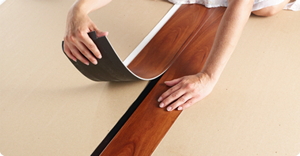
Figure 1 - Vinyl plank flooring
Note: When purchasing your vinyl plank flooring allow 10% additional material for waste.
Each vinyl plank has a self adhesive strip on one side and on one end which adheres to the adjacent vinyl plank, as shown in Figure 1.
It is relatively easy to install and even a novice handyman should be able to complete a near perfect installation. Its biggest installation advantage is that the floor can be completely laid prior to actually adhering any of the vinyl planks together. This allows the homeowner to see the finished flooring project before the actual installation begins.
As with most products and materials there are some rules associated with the installation of vinyl plank flooring.
Do Not Install Vinyl Plank Flooring If One Or More Of These Conditions Exist:
- Over Particleboard
- Over Below grade resilient tile flooring
- Over Waferboard
- Over Cushion-backed vinyl flooring
- Over Carpet
- Over Hardwood flooring installed on concrete
- On stairs
- On Floors that sloop
- On Floors with floor drains
- On Single-layer wood subfloors
- In New construction (homes less than 1 year old)
Installation of Vinyl Plank:
Note: Door trims should be under-cut so that the vinyl plank flooring will have a minimum 1/16 inch clearance when placed under the door trim. It is important that the vinyl planks have freedom of movement under door trims.
- Remove all the appliances and furniture from the room. Remove all baseboard and any other floor trims or moldings from the base of walls and any other vertical surface.
- Check the sub-floor for any nails and/or screws that are not properly seated below the surface of the floor. Correct any fasteners that may interfere with the bottom of the vinyl plank flooring.
- Vacuum the area thoroughly to remove all dust and debris. Pay special attention to the gaps between the drywall and the sub-floor as it is not uncommon to have loose pieces of drywall joint compound, nails and screws in those areas.
- Determine the direction that the vinyl plank flooring will be installed. The most common direction is parallel to the longest wall, although it can be installed in any direction.
